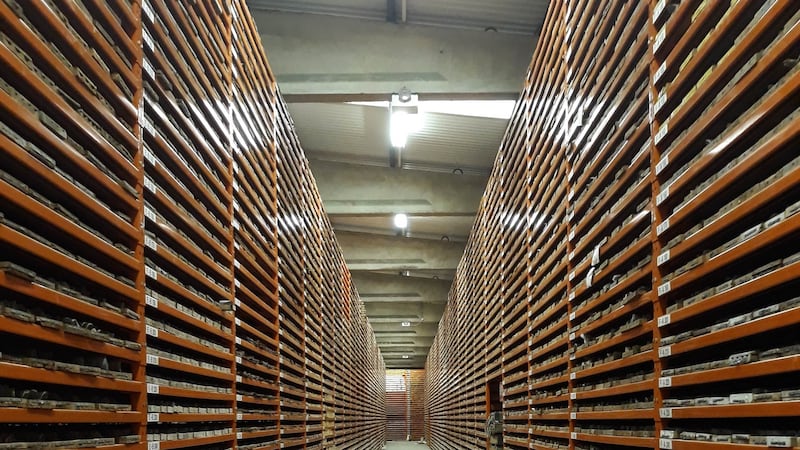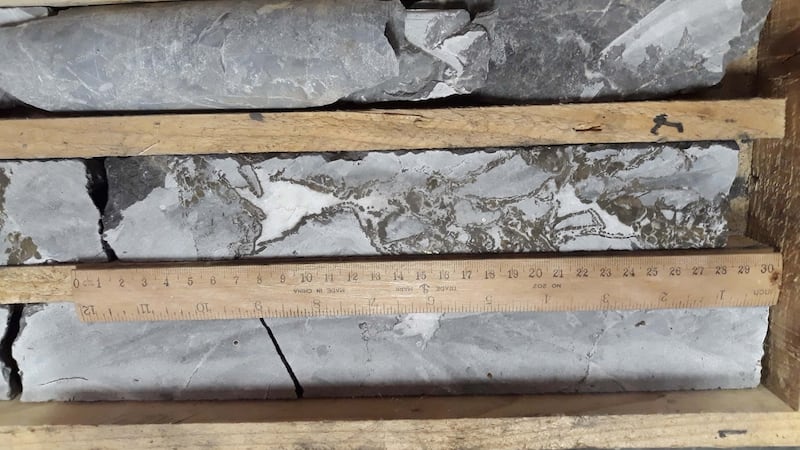Hidden between the maze of offices, coffee outlets and sandwich joints in Dublin's Sandyford region sits one of Ireland's most important, yet least known, collections of any kind. Here the Geological Survey of Ireland (GSI)'s core store is host to some thousands of sections of mud, dirt, ore and fossil – known as cores – retrieved from deep below the nation's surface.
The GSI’s cores are primarily used by exploration companies who harness an understanding of the hidden world beneath our feet, for use in extracting lucrative ores such as zinc and gold. But their purpose is not restricted to that: they also exhibit details used to uncover the secrets of subsurface hydrology, and have applications as far afield as understanding pure geology to unravelling our past climate history.
According to GSI Director Koen Verbruggen, the cores have a range of uses and are available to geologists and other interested researchers who wish to study them. "The core store has been used by researchers in a wide variety of geosciences," he says, "including stratigraphy, geochemistry, groundwater flow and mineralisation. For example, core is currently being used to investigate the thermal properties of different Irish rocks for studies in geothermal energy."


The ‘corestore’
Inside the core store – as the repository is known – Indiana Jones comes to mind. In Raiders of the Lost Ark, the final scene shows the Ark of the Covenant being stored away in a giant warehouse, host to various secret treasures. Here, in the Sandyford warehouse, along open corridors, stacked high on steal frames are thousands of carefully organised core sections from across each of the 32 counties.
Verbruggen explains that the store contains more than 300km of drill core with samples from over two thousand different drill holes.
“GSI has its own drilling rig for retrieving continuous rock samples, reaching over 1km below the ground surface,” he says. “We keep this core, as well as core selectively acquired from mineral exploration companies throughout Ireland, and make it available for geological purposes.”
The core store also contains numerous fossil-rich samples, particularly from the Carboniferous Period – which ended around 300 million years ago – when Ireland was covered by warm tropical seas and was rich in coral reefs. Such fossil samples are used extensively in the study of past climates.
"We also have samples from historic mine sites," says Verbruggen, "such as the old copper mines at Avoca in Wicklow and Allihies in Cork, or lead mines at Tynagh in Galway and Silvermines in Tipperary."
Water quality and availability
GSI's hydrogeologists also use the core for projects which look at the supply of drinking water. According to Monica Lee, a senior geologist who is head of the GSI's Groundwater Programme, "whether it's for a single house or for an industrial facility, people frequently need to know how much groundwater can be obtained from beneath their sites".
She explains that studying the core can tell us about the amount and size of cracks in the rock at a particular location and, therefore, the amount of water potentially being stored or flowing through.
“The core may also indicate how naturally occurring materials in the rock can be dissolved and end up in the groundwater,” explains Lee. “This includes hard water from limestone rocks, for example.”
In order to interpret the type of water flow through an area Lee’s team also create bedrock maps. “Much of their construction is based on interpreting the core, as well as mapping geological outcrops in the landscape,” she says.
In the future GSI intend to create even more high-resolution maps of bedrock and other relevant parameters, and will require the core store to be expanded so they can accept new additions to its archive. Efforts are currently under way to review the store holdings which include some unnecessary duplicates and core that is degraded beyond usefulness.
According Verbruggen, “ultimately, in the future, a new or larger core store is necessary, and discussions are already taking place with the OPW to find a suitable facility”.
Conor Purcell is a writer for Science and Nature with a PhD in Earth Science – some of his other articles at cppurcell.tumblr.com. Twitter: @ConorPPurcell
Aquifer maps
One of GSI Groundwater Programme’s roles is to classify a region’s groundwater resources into different types of aquifer, that is, a body of saturated rock through which water can easily move.
Aquifers are regularly used as a source for wells and are important for drinking water and irrigation projects. By classifying the aquifers across the country the GSI provide information to planners on water availability.
“The aquifers in Ireland are divided into three main groups,” says GSI senior hydrologist Monica Lee. “These are the regionally important, locally important, and poor aquifers.”
According to Lee, these categories are determined by studying and interpreting the rock, sand or gravel type, and combining the information with the available groundwater data.
“These groups are further split depending on how the groundwater flows through the aquifer, through the spaces in sand and gravel, or through cracks in the bedrock,” she adds.
New information from drilled boreholes and aerial land-mapping projects is increasingly being used by GSI, meaning that in the future we can expect an improved understanding of the nature of Ireland’s aquifers. Ultimately more accurate aquifer maps will become available for a range of applications.








